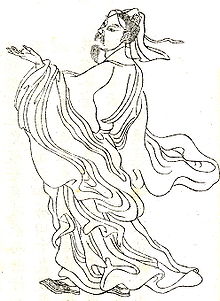Gu Kaizhi
Gu Kaizhi (simplified Chinese: 顾恺之; traditional Chinese: 顧愷之; pinyin: Gù Kǎizhī; Wade–Giles: Ku K'ai-chih; c. 344–406), courtesy name Changkang (長康), was a Chinese painter and politician. He was a celebrated painter of ancient China.[1] He was born in Wuxi and first painted at Nanjing in 364. In 366, he became an officer (Da Sima Canjun, 大司馬參軍). Later he was promoted to royal officer (Sanji Changshi, 散騎常侍). He was also a talented poet and calligrapher. He wrote three books about painting theory: On Painting (畫論), Introduction of Famous Paintings of Wei and Jin Dynasties (魏晉勝流畫贊) and Painting Yuntai Mountain (畫雲台山記). He wrote: "In figure paintings the clothes and the appearances were not very important. The eyes were the spirit and the decisive factor."

Quotes
edit- As Christianity transformed Mediterranean culture and art in the third and fourth centuries after Christ, so Buddhism, in the same centuries, effected a theological and esthetic revolution in the life of China. While Confucianism retained its political power, Buddhism, mingling with Taoism, became the dominating force in art, and brought to the Chinese a stimulating contact with Hindu motives, symbols, methods and forms. The greatest genius of the Chinese Buddhist school of painting was Ku K’ai-chih, a man of such unique and positive personality that a web of anecdote or legend has meshed him in.
- Will Durant and Ariel Durant, The Story of Civilization, Book I, Our Oriental Heritage (1935) (IV. PAINTING)
- He insisted on being a philosopher, too; under his portrait of the emperor he wrote: “In Nature there is nothing high which is not soon brought low. . . . When the sun has reached its noon, it begins to sink; when the moon is full it begins to wane. To rise to glory is as hard as to build a mountain out of grains of dust; to fall into calamity is as easy as the rebound of a tense spring.” His contemporaries ranked him as the outstanding man of his time in three lines: in painting, in wit, and in foolishness.
- Will Durant and Ariel Durant, The Story of Civilization, Book I, Our Oriental Heritage (1935) (IV. PAINTING)